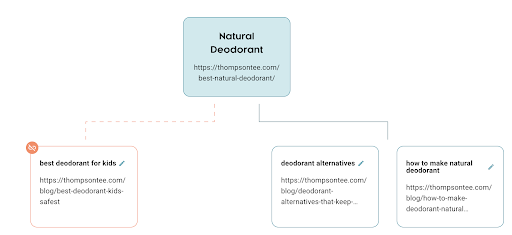The best blog post ideas seem to strike at the most unexpected times (for me, that’s in the middle of the night or a run).
Whether you’re actively planning content or have a moment of inspiration, you need a system for organizing topics to save time and prevent lost ideas.
Without a central location for storing topics and clear topic criteria, you’ll likely end up with fragments of ideas scattered across your desktop, notepads (or even scraps of paper). And when it comes time to write your blog post, that initial stroke of genius seems to fizzle.
To manage content production across clients and writers, I needed a system for organizing notes and standardizing ideas that could scale.
Over five years, we’ve carefully defined (and redefined) a process for managing ideas across dozens of clients that translates to high-quality content and impressive organic growth.
How to Track & Organize Blog Ideas to Save Time
When developing your system for tracking blog post ideas, don’t stop at the ideation process.
By considering the entire process — from ideation to execution — you can eliminate redundancies and channel that time into producing killer content.
Here’s how to get started:
1. Document Your Goals for Organizing Content Ideas
Whether you’re a freelance writer or work with a team, your goals for organizing content might look different.
Before evaluating tools or creating a system, understand what you’re trying to solve.
Are you struggling to keep track of ideas or experiencing communication breakdowns from idea to execution? Is saving time or improving quality important — or both?
Documenting your goals helps ensure your new process (and tools you select) alleviate your everyday pain points and save time.
At Human, our process for content creation focuses on these criteria:
- Actionable: Does the way we track blog post ideas make it easy and clear to execute?
- Efficient: Does the process ultimately save the team time?
- User-friendly: Can the entire team quickly adapt to the new process?
- Scalable: Is the process easy to replicate?
- Streamlined: Does our process eliminate unnecessary steps or tools?
2. Use Topics or Categories to Group Content Ideas
Applying the topic cluster model to your content strategy helps you organize content ideas, improve SEO performance and easily prioritize new content creation.
Our first step in content ideation is to identify the topics our clients want to be known for online and plan supporting content.
As you strategize content ideas, consider the topics that are most important to your business.
Free tools like Blueprint SEO help you organize content ideas by topic, so you can quickly see all related content and avoid overlapping ideas.
3. Outline Requirements for a Blog Post Idea
Have you written down a blog post topic — only to forget your original thought process behind it?
You should aim to create consistency in blog post topics, so you don’t need to go back to the drawing board when it comes time to write.
And that starts with answering some existential questions like: What does an idea even look like?
The best content starts with a specific, well-thought-out angle — it doesn’t stop at a catchy title.
When documenting ideas, consider any context or insight that will be needed during the writing process.
For our team, we require the following components for a completed blog post idea:
- Working title: What is the angle this blog post will take?
- Topic cluster: Which SEO topic does this idea support?
- Primary keyword: What do you want this blog post to rank for in search engines?
- Secondary keyword(s): What other related ideas should this piece cover?
- User intent: Why is the user performing this search? What do they hope to gain or learn?
- Target word count: How long or in-depth should the post go to fully cover the topic?
- Goal: What is the end result of this blog post?
4. Consider the Needs of All Users
When adopting a new system, it should work with you, not against you. After all, forming a new habit can take up to 254 days.
To make your process successful, keep the needs of all participants in mind.
If you’re a sole content creator, your system only depends on your work style, so ideas could live in physical calendars or notebooks. But if you have a team to consider, your system must be easy for anyone to implement (and likely digital).
5. Determine Your Ideal Workflow
What does your content creation process look like from idea to execution? What is the ideal flow of information that will ensure every blog post’s requirements are considered throughout the process?
Document the ideal workflow so you can plug in tools to fulfill some or all functions.
At Human, we focus on driving organic traffic through content. With that in mind, SEO goals need to drive the ideation and writing process.
Here’s the workflow we developed to achieve our SEO objectives:
- SEO research & strategy
- Ideation
- Outline
- Blog post draft
- Final edit
- Publishing
- Performance
6. Outline the Tools You Need to Support Each Step
What do you need to produce great content?
Take note of all tools you rely on throughout the process — including editorial calendars, word processors to write copy, grammar tools to catch errors, analytics tools to measure performance.
Visualizing the process and tools involved allows you to cut out needless steps and tighten up your workflow.
Our team uses the following tools to support the writing process:
- SEO research & strategy: SEMrush, Moz, Google, Blueprint SEO
- Ideation: Blueprint SEO
- Outline: Blueprint SEO
- Blog post draft: Google Doc
- Final edit: Google Doc, Grammarly
- Publishing: CMS (WordPress, HubSpot, etc.)
- Performance: Blueprint SEO, Moz
7. Consolidate Your Tools Where Possible
Tracking down content ideas, notes, outlines and performance data is time-consuming.
To streamline your content organization process, look for tools that serve multiple functions.
For example, is there a central tool to store content ideas and see performance data?
At Human, our goal is to produce original, authoritative content that ranks. But when managing multiple clients and writers, we needed a way to organize blog post ideas at scale.
That’s why we created Blueprint SEO — a content strategy tool that lets you organize content around topics and measure SEO performance.
We now use Blueprint SEO across multiple steps in the process and have one tool to:
- Organize existing blog posts
- Document new blog post ideas
- Store blog post notes, competitor research and outlines
- Categorize ideas by topic
- View metrics like organic traffic and user behavior across pages and topics
Because Blueprint SEO allows for multiple users and client accounts, the entire content team can easily collaborate on content strategy and quickly navigate between clients.
Try Blueprint SEO free for a limited time to organize your content ideas and streamline your writing process!
.jpg)



